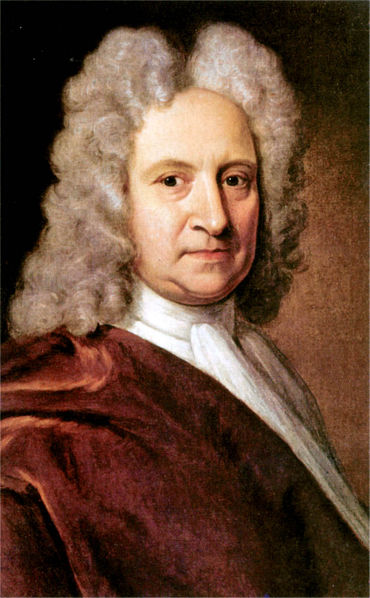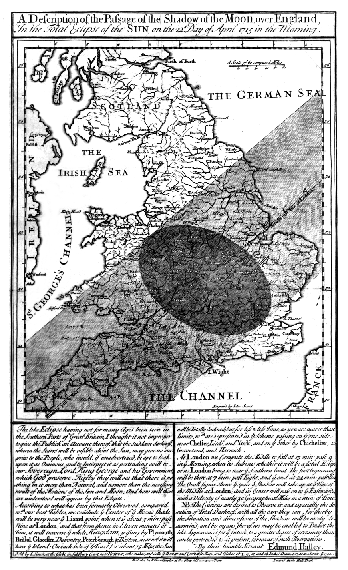
Sir Edmond Halley (1656-1741)
On November 8, 1656, English astronomer, geophysicist, mathematician, meteorologist, and physicist Sir Edmond Halley was born. Of course everybody has heard of Halley’s comet. We too already had an article on that topic [1]. But, Edmond Halley did much more than calculating the orbit of the eponymous comet. He compiled a catalogue of the stars of the Southern hemisphere, he also improved the sextant, and made observations about the ocean and the atmosphere. Along with the inventor and microscopist Robert Hooke, Sir Christopher Wren and Sir Isaac Newton, Halley was trying to develop a mechanical explanation for planetary motion.
Edmond Halley – Early Years
Edmond Halley was born in Haggerston, in east London, the son of Edmond Halley Sr., who came from a Derbyshire family and was a wealthy soap-maker in London. As a child, Halley was very interested in mathematics. He studied at St Paul’s School, and from 1673 at The Queen’s College, Oxford. While still an undergrad, he became a protégée of John Flamsteed [2], the Astronomer Royal, who later should become one of his major opponents. Halley made important observations at Oxford, including an occultation of Mars by the moon, and published papers on the solar system and on sunspots.[3]
St. Helena and the Southern Hemisphere
Halley gave up his studies in 1676 and sailed to St. Helena in the South Atlantic, where he catalogued 341 stars in the Southern Hemisphere and discovered a star cluster in Centaurus. He also made the first observation of a transit of Mercury and realized that a similar transit of Venus could be used to measure the size of the solar system. During the voyage, he also improved the sextant, and made observations about the ocean and the atmosphere. He returned to England in May 1678, to settle on behalf of the Royal Society a dispute about the observations of astronomer Johannes Hevelius,[15] which have been questioned by Robert Hooke since Hevelius didn’t use a telescope.[16] In 1679 Halley published the results from his observations on St. Helena as Catalogus Stellarum Australium which earned him comparison with Tycho Brahe, as e.g. “the southern Tycho” as described by Flamsteed. Halley was awarded his M.A. degree at Oxford and elected as a Fellow of the Royal Society at the age of 22, being among the youngest members.
Flamsteed, Newton, and the Principia
The fame and recognition which Halley achieved so quickly did nothing to endear him to Flamsteed who, despite his praise for Halley in his student days, soon turned against him. Having the Astronomer Royal as an enemy is not the best recommendation for a young astronomer, even one as famous as Halley.[6] For the next few years, Halley traveled and made observations. He observed a comet in Paris in 1680 and worked with Giovanni Cassini to determine its orbit.[17] In 1684, Halley, with fellow Royal Society members Christopher Wren and Robert Hooke,[18] visited Isaac Newton to discuss theories of planetary motion. Newton showed them his calculations. Halley persuaded Newton to expand his studies and allow him to edit the work. Halley paid all the expenses, corrected the proofs himself, and brought “Philosophiae Naturalis Principia Mathematica” to print in 1687.[19]
Diving and Magnetism
In 1691, Halley built a diving bell, a device in which the atmosphere was replenished by way of weighted barrels of air sent down from the surface.In a demonstration, Halley and five companions dived to 18 m in the River Thames, and remained there for over an hour and a half. Halley also suffered one of the earliest recorded cases of middle ear barotrauma. That same year, at a meeting of the Royal Society, Halley introduced a rudimentary working model of a magnetic compass using a liquid-filled housing to damp the swing and wobble of the magnetized needle.

Halley’s map of the path of the Solar eclipse of 3 May 1715 across England
Meteorology and Statistics
Halley had the ability to reduce large amounts of data to a meaningful order. In 1686 his map of the world, showing the distribution of prevailing winds over the oceans, was the first meteorological chart to be published. His mortality tables for the city of Breslau, (now Wrocław, Poland), published in 1693, comprised one of the first attempts to relate mortality and age in a population; as such, it influenced the future development of actuarial tables in life insurance. Under instructions from the Admiralty, he commanded the war sloop Paramore Pink in 1698–1700 on one of the first sea voyages undertaken for purely scientific purposes, this one to make measurements of the compass declination in the South Atlantic and to determine accurate latitudes and longitudes of his ports of call. [4]
Comets
Notwithstanding opposition from Flamsteed, Halley was appointed Savilian professor of geometry at Oxford in 1704. Continuing his pioneering work in observational astronomy, Halley published in 1705 A Synopsis of the Astronomy of Comets, in which he described the parabolic orbits of 24 comets that had been observed from 1337 to 1698. He showed that the three historic comets of 1531, 1607, and 1682 were so similar in characteristics that they must have been successive returns of the same visitant — now known as Halley’s Comet — and accurately predicted its return in 1758.
The Age of the Earth
Halley’s scientific attitude toward terrestrial physics led him to take an independent and novel approach to the question of the age of the earth. From investigations he made in 1693 on the rate of evaporation of water, he concluded that the salinity of lakes and oceans must gradually be increasing and suggested that if the rate of increase could be determined, it should be possible to obtain factual evidence about the earth’s age.[5]
Later Years
In 1716, he devised a method for observing transits of Venus across the disk of the sun in order to determine accurately the distance of the Earth from the Sun. In 1718, by comparing recently observed star positions with data recorded in the ancient Greek astronomer Ptolemy’s Almagest, he found that Sirius and Arcturus had slightly shifted their positions with respect to their neighbours. This was the discovery of what modern astronomers call proper motion.[4] In 1720, Halley succeeded Flamsteed as astronomer royal at Greenwich, a position which he held until his death on 14 January 1742. He did not survive to see the return of what later was named Halley’s Comet, on Christmas Day in 1758.
Rick Kennedy, Edmond Halley, James Cook, Fitzroy and Geodesy, [7]
References and Further Reading:
- [1] Sir Edmond Halley and his Famous Comet, SciHi blog.
- [2] John Flamsteed – Astronomer Royal, SciHi blog.
- [3] Tim Sharpe: Edmond Halley Biography: Facts, Discoveries and Quotes, at space.com
- [4] Sir Edmond Halley at Britannica Online
- [5] “Halley, Edmond.” Complete Dictionary of Scientific Biography. 2008. Encyclopedia.com
- [6] O’Connor, John J.; Robertson, Edmund F., “Edmond Halley“, MacTutor History of Mathematics archive, University of St Andrews.
- [7] Rick Kennedy, Edmond Halley, James Cook, Fitzroy and Geodesy, Rick Kennedy @ youtube
- [8] Oxford Dictionary of National Biography (2004). “Edmond Halley”. Westminster Abbey.
- [9] Halley, Edmond (1982). The Three Voyages of Edmond Halley in the Paramore, 1698–1701. UK: Hakluyt Society
- [10] Cook, Alan (2001). “Edmond Halley and the Magnetic Field of the Earth”. Notes and Records of the Royal Society of London. 55 (3): 473–490.
- [11] Wakefield, Julie; Press, Joseph Henry (2005). Halley’s Quest: A Selfless Genius and His Troubled Paramore. USA: National Academies Press
- [12] Hughes, David W. (August 1985). “Edmond Halley, Scientist”. Journal of the British Astronomical Association. London, UK: British Astronomical Association. 95 (5): 193.
- [13] Seyour, Ian (1996). “Edmond Halley – explorer”. History Today. 46 (June): 39–44.
- [14] Edmond Halley at Wikidata
- [15] Johannes Hevelius and his Selenographia, SciHi Blog
- [16] Robert Hooke and his Famous Observations of the Micrographia, SciHi Blog
- [17] Giovanni Domenico Cassini and the Moons of Saturn, SciHi Blog
- [18] Sir Christopher Wren – Baroque Architect, Philosopher, Scientist, SciHi Blog
- [19] Sir Isaac Newton and the famous Principia. SciHi Blog
- [20] Edmond Halley Timeline via Wikidata






Pingback: Whewell’s Gazette: Year 2, Vol. #18 | Whewell's Ghost
Pingback: Whewell’s Gazette: Year 3, Vol. #13 | Whewell's Ghost